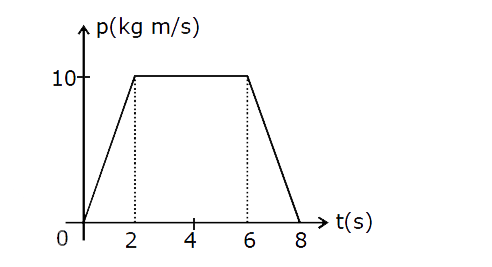The kinetic energy of a body is given by equation K=(2t3) Joule (t in sec).The correct graph shown between applied force (F) and time (t) is ………….




The correct Answer is:A
To solve the problem, we need to determine the relationship between the kinetic energy K of a body and the applied force F over time t. The kinetic energy is given by the equation:
K=2t3(in Joules)
Step 1: Find the expression for velocity
The kinetic energy K is related to the velocity v of the body by the formula:
K=12mv2
where m is the mass of the body. Rearranging this gives:
v2=2Km
Substituting the expression for K:
v2=2(2t3)m=4t3m
Taking the square root to find v:
v=√4t3m=2t3/2√m
Step 2: Find the expression for acceleration
The acceleration a is the time derivative of velocity v:
a=dvdt
Using the expression for v:
a=ddt(2t3/2√m)
Using the power rule of differentiation:
a=2√m⋅32t1/2=3t1/2√m
Step 3: Find the expression for force
Using Newton's second law, the force F is given by:
F=ma
Substituting the expression for a:
F=m⋅3t1/2√m=3√m⋅t1/2
Step 4: Analyze the relationship between force and time
From the equation F=3√m⋅t1/2, we see that force F is proportional to t1/2. This means that as time t increases, the force F increases with the square root of time.
Step 5: Determine the graph
The graph of F versus t will be a curve that starts at the origin and rises gradually, resembling the shape of a square root function.
Conclusion
Based on the analysis, the correct graph between applied force F and time t will show a curve that increases with the square root of time.
The kinetic energy K is related to the velocity v of the body by the formula:
The acceleration a is the time derivative of velocity v:
Using Newton's second law, the force F is given by:
From the equation F=3√m⋅t1/2, we see that force F is proportional to t1/2. This means that as time t increases, the force F increases with the square root of time.
The graph of F versus t will be a curve that starts at the origin and rises gradually, resembling the shape of a square root function.
Based on the analysis, the correct graph between applied force F and time t will show a curve that increases with the square root of time.
Similar Questions
Acceleration versus time graph of a body in SHM is given by a curve shown below. T is the time period. Then corresponding graph between kinetic energy KE and time t is correctly represented by

View SolutionIf the kinetic energy of a body is directly proportional to time t, the magnitude of the force acting on the body is
View SolutionThe x-t equation is given as x=2t+1. The corresponding v-t graph is
View SolutionThe position of a particle is given by the equation f(t)=t3−6t2+9t where t is measured in second and s in meter. Find the acceleration at time t. What is the acceleration at 4 s?
View SolutionKinetic energy of a particle moving in a straight line varies with time t as K=4t2. The force acting on the particle
View SolutionThe velocity of a body of mass 2kg as a function of t is given by υ(t)=2tˆi+t2ˆj Find the momentum and force acting on it at time t=2s.
View SolutionThe velocity of a body of mass 2kg as a function of t is given by υ(t)=2tˆi+t2ˆj Find the momentum and force acting on it at time t=2s.
View SolutionForce applied on a body is given by ltbygt F=(3t2−2t+10)N where t is in seconds. Find impulse imparted in t=0 to t=2 sec.
View SolutionThe momentum p of an object varies with time (t) as shown in figure. The corresponding force (F)- time (t) graph is -

View SolutionThe displacement -time (x– t) graph of a body is given as

The corresponding velocity -time (v – t ) graph will be
View Solution
